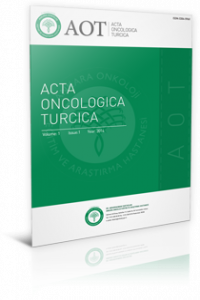Surgical Breast Biopsies and Complications: Is There an Effect on Future Treatments?
Komplikasyon, açık cerrahi meme biyopsisi, cerrahi alan infeksiyonu.
Açık Meme Biyopsileri ve Komplikasyonları: Gelecekteki Tedaviyi Etkiler mi?
___
- Morrow M. The evaluation of common breast problems. Am Fam Physician 2000;61:2371-8.
- Donegan WL. Evaluation of a palpable breast mass. N Engl J Med 1992;327:937-42.
- Parker SH, Lovin JD, Jobe WE, et al. Non-palpable breast lesions: Stereotactic automated large-core biopsies. Radiology 1991;180:403-7.
- Florentine BD, Cobb CJ, Frankel K, Graves T, Martin SE.
- Core needle biopsy. A useful adjunct to fine-needle aspirati- on in select patients with palpabl breast lesions. Cancer 1997;81:33-9.
- Brenner RJ, Bassett LW, Fajando LL, et al. Stereotactic core-needle breast biopsy: A multi-institutional prospective trial. Radiology 2001;218:866-72.
- Morrow M, Venta L, Slinson T, Bennett C. Prospective com- parison of stereotactic core biopsy and surgicai excision as diagnostic procedures for breast cancer patients. Ann Surg 2001;233:537-41.
- Tran CL, Larger S, Villa GB. Does reoperation predispose to postoperative wound infection in women undergoing opera- tion for breast cancer. Am Surg 2003;69:852-6.
- Löfgren M, Andersson i, Lindholm K. Stereotactic fine-need- le aspiration for cytoiogic diagnosis of non-palpable breast lesions. AJRAm J Roentgenol 1990;154:1191-5.
- Friese CR, Neville BA, Edge SB, Hassett MJ, Earie CC. Breast biopsy patterns and outcomes in surveillance, epidemiology, and end results-medicare data. Cancer 2009:115: 716-24.
- Oisen MA, Chu-Ongsakul S, Brandt KE, Dietz JR, Mayfield J, Fraser VJ. Hospital-associated costs due to surgicai site infection after breast surgery. Arch Surg 2008;143:53-60.
- Viiar-Compte D, Jacquemin B, Robles-Vidal C, Voikow P. Surgicai site infections in breast surgery: Case-control study. World J Surg 2004;28:242-6.
- Zoutman D, Pearce P, McKenzie M, Taylor G. Surgicai wound infections occurring in day surgery patients. Am J Infect Control 1990;18:277-82.
- ReyJE, Gardner SM, Cushing RD. Determinants of surgicai site infection after breast biopsy. Am J Infect Control 2005; 3:126-9.
- Nori J, Bazzocchi M, Boeri C, et al. Role of axillary iymph node ultrasound and iarge core biopsy in the preoperative assessment of patients seiected for sentineI node biopsy. Radiol Med 2005;109:330-44.
- Karakaya M, Karaman N, Özaslan C, Kurukahvecioğiu O, Bircan HY, Altınok M. Meme kanseri cerrahisi sonrası yara komplikasyonları. Meme Sağlığı Dergisi 2006;2:85-8.
- MahmoudB, EI-TamerB, Marie W, TracyS. Morbidity and mor- tality follovving breast cancer surgery in women national bench- marks for standards of çare. Ann Surg 2007;245:665-71.
- Lipshy KA, Neifeld JP, Böyle RM, et al. Complications of mastectomy and their relationship to biopsy technique. Ann Surg Oncoi 1996;3:290-4.
- Saint-Jacques N, Younis T, Dewar R, Rayson D. Wait times for breast cancer çare. Br J Cancer 2007;96:162-8.
- Hail JC, Hail JL. Antibiotic prophylaxis for patients undergo ing breast surgery. J Hosp Infect 2000;46:165-70.
- Rotstein C, Ferguson R, Cummings KM, Piedmonte MR, Lucey J, Banish A. Determinants of clean surgicai wound infections for breast procedures at an oncology çenter. Infect Control Hosp Epidemiol 1992;13:207-14.
- D'Amico DF, Parimbelli P, Ruffolo C. Antibiotic prophylaxis in clean surgery: Breast surgery and hernia repair. J Chemother 2001; 13:108-11.
- Penel N, Yazdanpanah Y, Chauvet MP, et al. Prevention of surgicai site infection after breast cancer surgery by targe- ted prophylaxis antibiotic in patients at high risk of surgicai site infection. J Surg Oncoi 2007;96:124-9.
- ISSN: 0304-596X
- Başlangıç: 2015
- Yayıncı: Dr. Abdurrahman Yurtaslan Ankara Onkoloji EAH
A Case of Schvvannoma Arising from Brachial Plexus
Hayriye KARABULUT, Baran ACAR, Mehmet Ali BABADENİZ, Gülçin ŞİMŞEK, Emre GÜNBEY
Thromboembolic Complications of Cancer and Management
Yeşim YILDIRIM, Özgür ÖZYILKAN
Multidedector Computed Tomography Findings of Crohn 's Disease
Kaposi Sarcoma Presented on Glans Penis
Tolga TUNCEL, Ahmet ALACACIOĞLU, Bülent KARAGÖZ, Oğuz BİLGİ, Alpaslan ÖZGÜN, Zafer KÜÇÜKODA, Emin Gökhan KANDEMİR
Clinicopathological Characteristics of Ninety MaHgnant Melanoma Patients
Mutlu DOĞAN, Ülkü YALÇINTAŞ ARSLAN, Saadet TOKLUOĞLU, Güze ÖZAL, Hande SELVİ, Güngör UTKAN, Hakan AKBULUT, Bülent YALÇIN, Necati ALKIŞ, Fikri İÇLİ
Surgical Breast Biopsies and Complications: Is There an Effect on Future Treatments?
Lutfi DOĞAN, Niyazi KARAMAN, Cihangir ÖZASLAN, Can ATALAY, Mehmet ALTINOK
Renal Celi Carcinoma in an Ectopic Kidney: Case Report
Niyazi KARAMAN, Lütfi DOĞAN, Cihangir ÖZASLAN, Can ATALAY, Çiğdem IRKKAN, Asuman BOZKURT
Ultrasonography Guided Pancreatic Needle Biopsies
Bilgin Kadri ARIBAŞ, Gürbüz DİNGİL, Ümit ÜNGÜL, Gürsel ŞAHİN, Dilek Nil ÜNLÜ, Kamil DOĞAN, Sevim ÖZDEMİR, Zekiye PEKOL ŞİMŞEK, Aliye Ceylan ZARALI, Rasime Pelin DEMİR, Kemal ARDA
Primary Lung Cancer vvith Invasion Into the Atrium: Two Case Report
Nazan ÇİLEDAĞ, Pelin DEMİR GÜMÜŞDAĞ, Elif AKTAŞ, Kemal ARDA
Gülbahar GÜLNERMAN, Selma KELEŞ, Menşure KAYA, Neslihan KURU, Nihal KADIOĞULLARI
